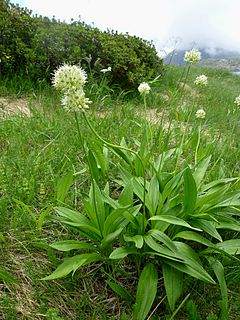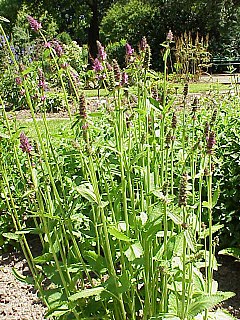 W
WAralia elata, the Japanese angelica tree, Chinese angelica-tree, or Korean angelica-tree, is a woody plant belonging to the family Araliaceae. It is known as tara-no-ki in Japanese, and dureup-namu (두릅나무) in Korean.
 W
WAkebia is a genus of five species of flowering plant, within the family Lardizabalaceae. The scientific name, akebia, is a Latinization of the Japanese name for species Akebia quinata: akebi (通草).
 W
WAllium ochotense, the Siberian onion, is a primarily East Asian species of wild onion native to northern Japan, Korea, China, and the Russian Far East, as well as on Attu Island in Alaska.
 W
WAllium victorialis, commonly known as victory onion, Alpine leek, and Alpine broad-leaf allium is a broad-leaved Eurasian species of wild onion. It is a perennial of the Amaryllis family that occurs widely in mountainous regions of Europe and parts of Asia.
 W
WAngelica keiskei, commonly known under the Japanese name of ashitaba , literally "tomorrow's leaf", is a species of flowering plant in the carrot family. It is native to Japan, where it is found on the Pacific Coast. It is native to the area of the Bōsō Peninsula, Miura Peninsula, Izu Peninsula, and the Izu Islands. It has been widely cultivated outside its natural range.
 W
WBamboo shoots or bamboo sprouts are the edible shoots of many bamboo species including Bambusa vulgaris and Phyllostachys edulis. They are used as vegetables in numerous Asian dishes and broths. They are sold in various processed shapes, and are available in fresh, dried, and canned versions.
 W
WBracken (Pteridium) is a genus of large, coarse ferns in the family Dennstaedtiaceae. Ferns (Pteridophyta) are vascular plants that have alternating generations, large plants that produce spores and small plants that produce sex cells. Brackens are noted for their large, highly divided leaves. They are found on all continents except Antarctica and in all environments except deserts, though their typical habitat is moorland. The genus probably has the widest distribution of any fern in the world.
 W
WBrasenia is a genus belonging to the family Cabombaceae, consisting of one species, Brasenia schreberi. It is widely distributed in North America, the West Indies, northern South America, eastern Asia, Australia, the Indian Subcontinent, and parts of Africa.
 W
WMizuna , kyona, Japanese mustard greens, or spider mustard, is a cultivar of Brassica rapa var. niposinica.
 W
WDaikon or mooli, Raphanus sativus var. longipinnatus, is a mild-flavored winter radish usually characterized by fast-growing leaves and a long, white, napiform root. Originally native to continental East Asia, daikon is harvested and consumed throughout the region, as well as in South Asia, and is now available internationally. In some locations daikon is planted for its ability to break up compacted soils and recover nutrients, but not harvested.
 W
WPetasites japonicus, also known as butterbur, giant butterbur, great butterbur and sweet-coltsfoot, is an herbaceous perennial plant in the family Asteraceae. It is native to China, Japan, Korea and Sakhalin and introduced in Europe and North America. It was introduced to southern British Columbia in Canada by Japanese migrants.
 W
WHijiki , sometimes called hiziki, is a brown sea vegetable growing wild on rocky coastlines of East Asia.
 W
WDaikon is a generic term for radish in Japanese language. For example, European radish is called hatsukadaikon (廿日大根) in Japan. In the West, the word daikon sometimes refers to long white Asian radish varieties and sometimes Japanese radish varieties. When it is necessary to distinguish the usual Japanese form from others, it is sometimes known as Japanese radish or "true daikon".
 W
WDioscorea japonica, known as East Asian mountain yam, yamaimo, or Japanese mountain yam, is a type of yam (Dioscorea) native to Japan, Korea, China, Taiwan, and Assam.
 W
WBrasenia is a genus belonging to the family Cabombaceae, consisting of one species, Brasenia schreberi. It is widely distributed in North America, the West Indies, northern South America, eastern Asia, Australia, the Indian Subcontinent, and parts of Africa.
 W
WKabocha is a type of winter squash, a Japanese variety of the species Cucurbita maxima. It is also called kabocha squash or Japanese pumpkin in North America. In Japan, "kabocha" may refer to either this squash, to the Western pumpkin, or indeed to other squashes.
 W
WDaikon or mooli, Raphanus sativus var. longipinnatus, is a mild-flavored winter radish usually characterized by fast-growing leaves and a long, white, napiform root. Originally native to continental East Asia, daikon is harvested and consumed throughout the region, as well as in South Asia, and is now available internationally. In some locations daikon is planted for its ability to break up compacted soils and recover nutrients, but not harvested.
 W
WKomatsuna or Japanese mustard spinach is a leaf vegetable. It is a variety of Brassica rapa, the plant species that yields the turnip, mizuna, napa cabbage, and rapini. It is grown commercially in Japan and Taiwan. It is a versatile vegetable that is cooked and eaten in many ways. The plant is also used for fodder in some Asian countries.
 W
WNelumbo nucifera, also known as Indian lotus, sacred lotus, or simply lotus, is one of two extant species of aquatic plant in the family Nelumbonaceae. It is sometimes colloquially called a water lily, though this more often refers to members of the family Nymphaeaceae.
 W
WMatteuccia is a genus of ferns with one species: Matteuccia struthiopteris. The species epithet struthiopteris comes from Ancient Greek words στρουθίων (strouthíōn) "ostrich" and πτερίς (pterís) "fern".
 W
WMung bean sprouts are a culinary vegetable grown by sprouting mung beans. They can be grown by placing and watering the sprouted beans in the shade until the hypocotyls grow long. Mung bean sprouts are extensively cultivated and consumed in East and Southeast Asia.
 W
WNanohana is a cruciferous green vegetable, closely related to rapini and broccoli, which is commonly used in Japanese cuisine. The term nanohana specifically refers to the young shoots of the rapeseed plant, while the mature plant, which is used to produce rapeseed oil, is called aburana. The florets, stems, and leaves are all edible, and are commonly boiled and served with dashi (stock) and katsuobushi. The shoots may also be pickled or served as a salad with mustard. A festival celebrating the spring bloom of nanohana, called Nanohana Matsuri, is held annually in Japan.
 W
WOriental pickling melon, called wolgwa in Korean, and shirouri in Japanese, is a group of nonsweet melon cultivars used in Asian cuisines.
 W
WPteridium aquilinum, also known as eagle fern, is a species of fern occurring in temperate and subtropical regions in both hemispheres. The extreme lightness of its spores has led to its global distribution.
 W
WSansai (山菜) is a Japanese word literally meaning "mountain vegetables", originally referring to vegetables that grew naturally, were foraged in the wild, and not grown and harvested from fields. However, in modern times, the distinction is somewhat blurred, as some sansai such as warabi have been successfully cultivated. For example, some of the fern shoots such as bracken (fiddlehead) and zenmai shipped to market are farm-grown.
 W
WColocasia esculenta is a tropical plant grown primarily for its edible corms, a root vegetable most commonly known as taro, kalo, dasheen, madhumbe, marope, magogoya, patra, arbi or godere. It is the most widely cultivated species of several plants in the family Araceae that are used as vegetables for their corms, leaves, and petioles. Taro corms are a food staple in African, Oceanic, and South Asian cultures, and taro is believed to have been one of the earliest cultivated plants.
 W
WShishito pepper is a mildly spicy, East Asian pepper variety of the species Capsicum annuum. It is known as kkwari-gochu in Korea because its wrinkled surface resembles groundcherries.
 W
WStachys affinis, commonly called crosne, Chinese artichoke, Japanese artichoke, knotroot, or artichoke betony, is a perennial herbaceous plant of the family Lamiaceae, originating from China. Its rhizome is a root vegetable that can be eaten raw, pickled, dried or cooked.
 W
WAralia elata, the Japanese angelica tree, Chinese angelica-tree, or Korean angelica-tree, is a woody plant belonging to the family Araliaceae. It is known as tara-no-ki in Japanese, and dureup-namu (두릅나무) in Korean.
 W
WAralia cordata is an upright herbaceous perennial plant growing up to 2 to 3 metres in height, native to Japan, Korea and eastern China. Its common names include spikenard, herbal aralia, udo, Japanese spikenard, and mountain asparagus. It is commonly found on the slopes of wooded embankments. Aralia cordata is a species of Aralia in the family Araliaceae.